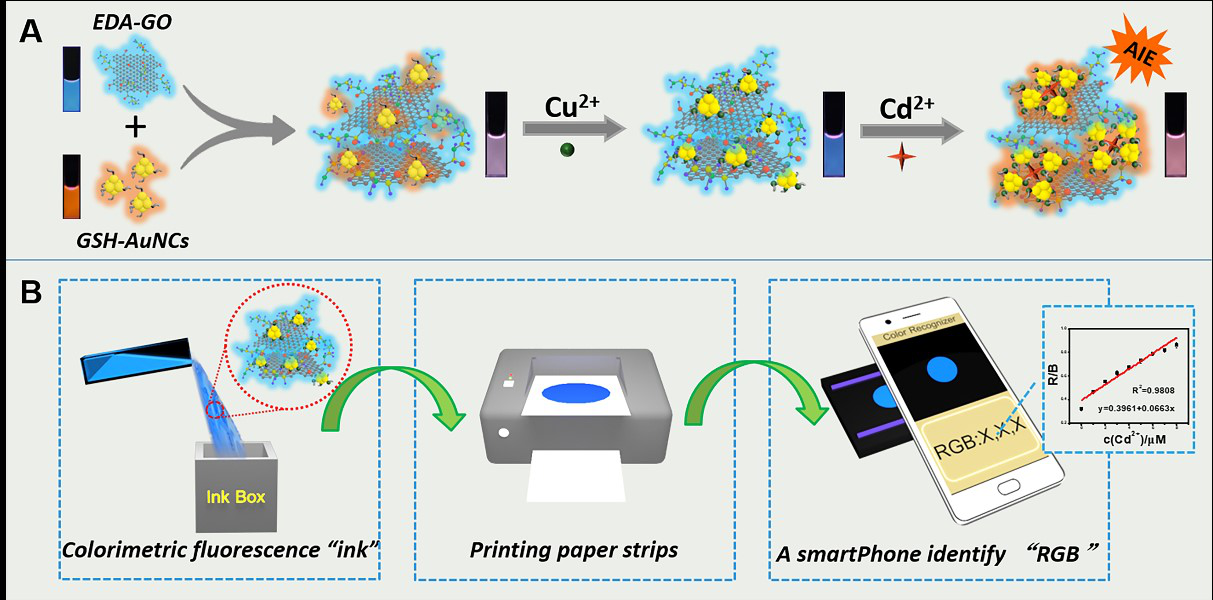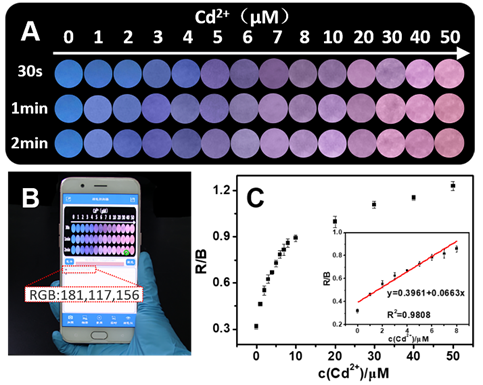
A Chinese research team from Institute of Intelligent Machines, Hefei Institutes of Physical Science developed an effective colorimetric fluorescent sensor for detection of cadmium ions in real samples, and achieved visual and quantitative detection by printing the paper strip with fluorescence probe solution and a smartphone application.
Cadmium ions (Cd2+) are a kind of toxic metal ion released by industries, which are seriously harmful to animals, plants and human health. The fluorescent sensors for detecting Cd2+ are mostly monochromatic fluorescence in previous reports. However, the increase or decrease of single emission has defects in visual discrimination and analysis accuracy.
In contrast, colorimetric fluorescent sensors contain two different wavelengths of emission, which makes color changes more easily distinguishable and greatly improves detection accuracy by analyzing emission intensity ratio to provide built-in correction of environmental impact.
In addition, it was well acknowledged that quantitative detection is very critical for the timely/effective monitoring in various fields such as environmental management, food/drug quality control, clinical diagnosis and societal safety screening. Most quantitative analyses need to be performed with the aid of expensive laboratory instruments and skilled persons, which are time-consuming and not suitable for real-time and on-site assays.
The team reported a colorimetric fluorescent sensor for detecting cadmium ions, and further designed a colorimetric fluorescence paper strip combined with a smartphone analysis platform for the visualization, on-site and quantitative detection of cadmium ions.
According to the study, the blue-emitting colorimetric fluorescent sensor constituted by orange-emitting gold nanoclusters (AuNCs), blue-emitting luminescent graphene oxide (EDA-GO) and copper ions (Cu2+).
Cadmium ions could induce the accumulation of Cu2+-GSH-AuNCs of the colorimetric fluorescence sensor to emit strong orange fluorescence, which changed the color of the fluorescence sensor from blue to red, and the limit of detection (LOD) was as low as 33.3 nM.
In addition, the researchers prepared fluorescent paper strips using the colorimetric fluorescent solution, and combined with the color recognition program of a smartphone to build a rapid analysis platform.
Based on the linear relationship between the RGB value of the paper strip and the concentration of cadmium ions, a sensitive and quantitative detection of cadmium ions in rice samples was performed, with a low LOD of 0.1 μM.
The rapid quantitative analysis method provided by this study has great application potential in real-time monitoring of food safety and environmental protection.
This work was financially supported by National Natural Science Foundation of China, the Key Project of Collegiate Natural Science Fund of Anhui Province, and the Key Research and Development Program of Anhui Province.

Schematic diagram of detection of Cd2+ by AIE colorimetric fluorescent sensor (A) and integrated fluorescent paper strips with smartphone platform (B). (Image by WANG Haiqian )

The variation of fluorescent paper strip (A). A smartphone recognizes the RGB values of paper strips (B). The relationship of R/B values of paper strips and concentration of Cd2+ (C). (Image by WANG Haiqian)

86-10-68597521 (day)
86-10-68597289 (night)

52 Sanlihe Rd., Xicheng District,
Beijing, China (100864)

